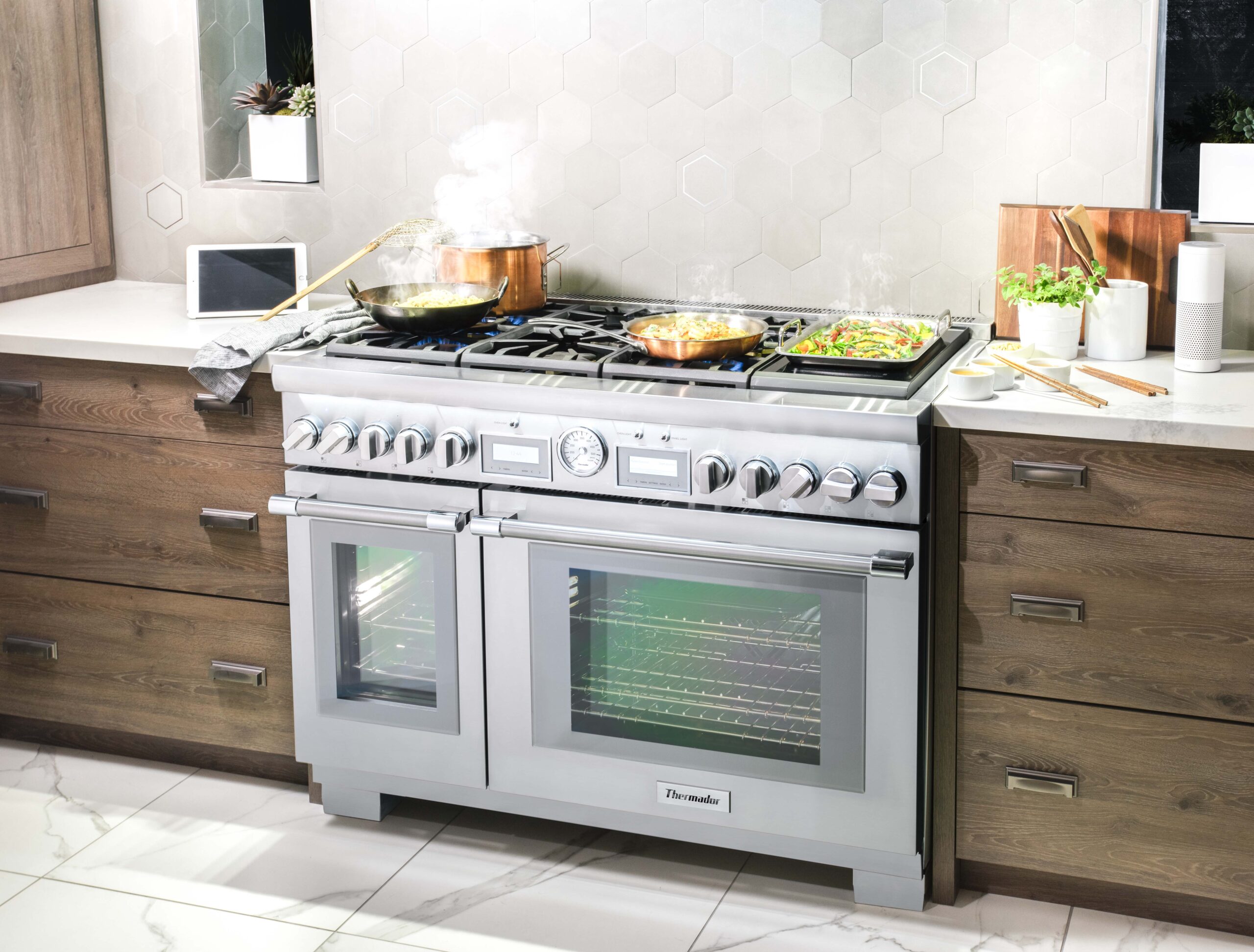

A dishwasher may not be the most glamorous appliance in the kitchen, but it’s an essential piece of the prep-cook-clean rotation. If you aren’t sure how much you rely on your dishwasher, unplug it for a couple weeks. You’ll likely discover it’s the underappreciated workhorse of your kitchen appliances. Using a dishwasher instead of hand-washing saves you an average of 230 hours of labor, according to Energy Star. And while hand-washing may seem like the eco-friendly thing to do, dishwashers actually save water, too. Hand-washing one load of dishes can take up to 27 gallons of water while most standard dishwashers use between 4 to 6 gallons.
When it’s time to shop for a new dishwasher, you’ll want to explore all the options out there. The most popular dishwashers are built-ins, which fit snuggly between cabinets and under counters, but there are countertop, portable, and in-drawer dishwashers too. Most modern options come in a variety of finishes and offer feature like energy efficiency, adjustable racks, and multiple cycles. Higher-end models can do even more things to may make your life easier, from delayed start to auto-release, which tells the dishwasher to crack open its door at the end of the wash to release steam for a more thorough dry. So, what is the best dishwasher for you?
Here’s a guide to help you better understand what’s out there so you can choose the right one for your kitchen.
Cost
First, let’s talk about cost: For built-in dishwashers, expect price tags at $400 to $500 for budget machines, $700 to $1,200 for midrange models, and $2,500 to $4,000 for ultra-premium luxury dishwashers.
Space and Layout Considerations
There are a few basic guidelines to follow when determining where your dishwasher should go. Most kitchens have a designated space for a standard-size dishwasher, but if you’re renovating and you have the flexibility to choose its new home within your kitchen layout, think about the following:
- Your dishwasher needs to be near the sink, so it can share its water supply and drain.
- You’ll want to be able to open the dishwasher door completely and still be able to stand at the sink so you can easily scrape, rinse, and load your dishes.
- Make sure there’s a minimum of 27 inches of space between the fully extended dishwasher door and facing cabinets.
- Place the dishwasher near the drawers and cabinets where you’ll be putting away dishes, silverware, and glasses, and make sure those drawers and cabinets can be opened while the dishwasher door is open.
- The dishwasher shouldn’t block a workspace or heavily trafficked walkway.
- If you plan on putting your dishwasher under a kitchen island with a sink, make sure the proper plumbing is in place.
Garth Blackburn, an outside sales representative at The Jarrell Company, says keep a dish flow pattern in mind, which includes the sink and trash can. He recommends a trash can and sink side-by-side for scraping and rinsing, and a dishwasher and counterspace on the other side for clean dishes and hand-washed items to dry.
Features to Consider
Here’s where it gets good. After selecting the size (more on that below), you get to choose the style, your top priorities, and all the extra bells and whistles you want. Here’s a breakdown of what’s available.
Size and Capacity
Most kitchens are built to accommodate a standard dishwasher, which is 24 inches wide, 24 inches deep, and 35 inches tall. Compact dishwashers, which are great for small families and compact kitchens, measure 18 inches wide. If you’re redesigning your kitchen, you also can consider oversized dishwashers, which run between 30 to 42 inches wide (and usually come in standard depth and height).
The next question is: Which dishwasher will fit your dishes? Dishwashers are given a capacity number, which is measured by how many place settings a dishwasher can hold at once. (A standard-size machine holds about 10 to 12 place settings.) Blackburn says don’t get too hung up over the capacity number. Instead, he says, “Think about your own dishes.” An outstanding feature of some dishwashers is adjustability, which allows racks and tines to be moved around to accommodate various shapes and sizes of dishes and glassware. Blackburn says shoppers are welcome to bring their own plates and glasses into the showroom to get a better feel for which machine is the best fit.
Style/Look/Materials
Most dishwashers come in the expected popular colors (silver, white, black, and slate), and the most popular finishes are stainless steel and panel-ready, which allows built-in dishwashers to be covered with panels so the dishwasher blends in seamlessly with surrounding cabinetry.
Models are also being designed to look smarter and sleeker, with recessed handles and hidden control panels that are only visible when you open the dishwasher.
It’s also important to consider the interior materials. The inside tubs can be made of plastic or stainless steel. While plastic is less expensive, stainless steel is more durable, can reach higher temperatures to kill bacteria, and dries more quickly.
Noise Level
Dishwashers are a rated on a dBA scale (a decibel measurement system for human hearing). Most dishwashers range from 40 to 60 dBA. For reference, 40 dBA is compared to “quiet library sounds” while 60 dBA is equated to an electric toothbrush. A dishwasher with a decibel level of 44 dBA is considered quiet, and anything rated 40 dBA and under considered nearly silent. However, Blackburn says not to worry too much about the number.
“If you haven’t been in the market for a dishwasher for a while, you probably don’t know how quiet models have become,” he says. So, as long as you’re not looking at a plastic tub over 60 dBA, your dishwasher is likely to be discreet.
In fact, because newer models have become so quiet, some brands have installed features that notify you when a cycle is finished. And Bosch, Kitchen Aid, and GE’s Monogram line all have either display lights on the door or a light that shines on the ground to let you know when the unit is running. Thermador even has a model with a digital clock that shines on the floor so you can see exactly how much longer it will be until your dishes are dry and ready to put away.
Performance
Shoppers tend to focus on noise level and capacity, Blackburn says, but you want your dishwasher to excel at its primary purpose: cleaning your dishes. Independent labs do assessments on dishwashers and can help point you in the right direction.
Additionally, Blackburn says to look for adaptability. High-end dishwashers are the more adjustable, he says. “So you don’t have to learn how to load your dishwasher differently; you adjust the dishwasher to your dishes.”
Find out what a manufacturer provides for leak protection. Dishwashers are considered the second most common appliance to do floor damage, Blackburn says. What does the dishwasher have that will prevent water leaking on your floors?
Shop for drying ability. Different brands have different methods of drying. Some use condensation methods, heaters, or proprietary mineral technologies which zap dishes bone dry so they can be put on the shelf right away.
Efficiency (Water usage, Energy)
Nearly any new dishwasher will use less water than hand-washing. The Department of Energy requires all full-size dishwashers to use a maximum of 5 gallons of water per cycle. Energy Star-rated dishwashers require even less at 3.5 gallons per cycle. In comparison, washing that same load by hand could use up to 20 gallons of water. Energy Star models must also use less energy than non-certified dishwashers, which saves you dollars in energy costs over the course of the year.
The trade-off is speed. Like with energy-efficient washing machines, in order to get things sparkling clean with less water, it takes longer.
Well-Designed Functional Features
Features on some the best dishwashers do more than just punch up the price. They can really improve the entire dish-washing experience. Here are some features worth considering:
- Adjustable racks: racks that can be moved higher or lower, and adjustable tines that can be collapsed
- Third rack: a top row for silverware, small bowls, sippy cup lids, straws, and large utensils like tongs, spatulas, and serving spoons
- Specialized cycles: in addition to light, normal, heavy and quick, some machines have cycles for sanitizing, pot scrubbing, delicate China, or single-rack wash
- Delayed wash cycle: set your dishwasher to begin from one to 24 hours later
- Wash zones: heavier wash zones to place your dirtiest dishes
- Bottle jets: for high-pressure squirting directly inside baby bottles, water bottles, or coffee cups with stuck-on stains
- AutoDose: fill the dishwasher with extra detergent and let the soil sensor and cycle setting select the proper detergent dose for you
- Utensil spray jets: models by some brands (like GE’s Café and Monogram) have dozens of small spray jets that use high-pressure spray on silverware to get them cleaner
- Interior lighting: to illuminate dishes inside the machine for easier loading and unloading
- Automatic door open: some machines have doors that automatically open at the end of the wash to let steam escape and dry more thoroughly
Other Available Options
Double dishwashers. “We’re increasingly seeing more people put in two dishwashers,” Blackburn says. “Not because they have more dishes, but because people like having a place for dirty dishes to land while one dishwasher is running or hasn’t yet been emptied.”
The Jarrell Company also sells the dishwasher drawers that are exclusive to Fisher & Paykel, which offer the convenience of not having to bend down to load and unload. They come in single drawers (perfect for a bar area) and double drawers, which can be run independently of each other.
Top-Rated Brands to Consider
Cove is Blackburn’s go-to top-tier niche brand for high-performance, extensive leak protection, and adjustability, but Bosch is a close runner-up at half the price. Still, Thermador, GE Monogram and Café, and KitchenAid have lots to offer dishwasher shoppers, including quiet machines, high performance, and helpful features.
Dishwashing PSA
Stop rinsing your dishes before you load them up in your dishwasher.
Most modern dishwashers have sensors inside of them that detect the soil level of your dishes. (In geek speak, they’re called turbidity sensors.) Even if you press “normal” wash, your dishwasher will use this information to automatically adjust the amount of energy, water, and time it uses to clean the load. If your dishwasher doesn’t detect enough soil, it may not offer up the most thorough clean. Scrape the largest chunks of food off plates and pop them right into the dishwasher without rinsing. That’s right. No rinsing.
If you’re still not convinced, consider potential damage to your dishes. “If you’re running that detergent over clean plates and bowls, the detergent is going to start scratching your glassware,” Blackburn says. Called “etching,” these marks can make glassware look hazy.
Find Kitchen Appliances for Your Remodel at The Jarrell Company
Whether you’re looking to treat yourself to a single appliance upgrade or build the kitchen of your dreams from scratch, we work directly with customers, designers and builders to make it happen. Check out appliances and brands online, or visit us in store to chat with our friendly sales team who can help guide you to the right appliances.


